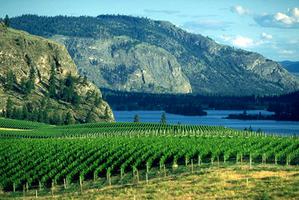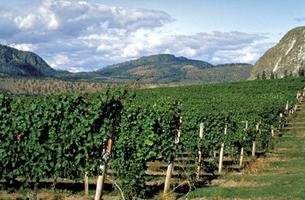The Okanagan Valley is in south-central British Columbia, extending about 200 km north from the American border. Originally home to the Okanagan First Nations, cities in the region now include Vernon, Kelowna and Penticton. The area is one of the largest producers of fruit and wine in Canada.
Geography
The Okanagan Valley is roughly 200 km long and 20 km wide. It lies between the Columbia and Cascade mountain ranges in south-central British Columbia. Its landscape of low hills and oblong lakes was formed by glacial activity during the Pleistocene epoch, the final retreat of the ice between 11,000 and 9,000 years ago. The glaciers left large deposits of gravel, silt and sand on the bottom and sides of the valley. These sediments were eroded by water and wind, resulting in large alluvial fans (i.e., triangle-shaped deposits of sediment) and deltas such as those on which the cities of Vernon, Kelowna and Penticton partly stand; these sediments are now used for agriculture. The valley includes several lakes, all of which were once part of a large glacial lake. The largest of these lakes is Okanagan Lake. From east to west are Swan, Kalamalka and Wood lakes and to the south lie Skaha, Vaseux and Osoyoos lakes. The whole system drains south through the Okanagan River into the Columbia River.
Climate
The valley lies in the rain shadow of the Coast and Cascade mountains, creating a hot, sunny, dry climate. Most of the valley receives about 2,000 hours of sunlight per year and 250–400 mm of precipitation. The southern valley, which gets about 300 mm of precipitation, is desert-like, with cacti, rattlesnakes and mantids.
People
The Okanagan Valley was first inhabited by the Okanagan of the Interior Salish, who gave the valley its name, translated roughly as "place of water." There are large reserves on the northwest arm of Okanagan Lake, southwest of the lake and north of Osoyoos, and others near Enderby and Kelowna.
The three largest population centres are Kelowna, Penticton and Vernon. Enderby and Armstrong lie in the dairy and vegetable-growing region of the northern valley, and Okanagan Falls, Oliver and Osoyoos lie in the dry fruit-growing area south of Penticton.
European Settlement
David Stuart, a Scottish fur trader employed by the Pacific Fur Company, is credited as the first European to see the valley in 1811. His cousin, John Stuart of the Hudson’s Bay Company, followed the trail in 1814 through the valley that continued to be used until 1847 by fur traders and later, miners. Missionaries built the first settlement at the head of Okanagan Lake in about 1840 and near Kelowna in 1859. Some miners stayed on after a small gold rush at Cherry Creek (50 km east of Vernon), as did a few of the Overlanders of 1862. Ranching, in the northern valley, was the first viable industry.
Fruit Basket
Next to the Fraser River Lowlands, the Okanagan Valley is the most important agricultural region in British Columbia, the primary crop being fruit trees. The first apple trees were planted by Hiram "Okanagan" Smith near Osoyoos (ca. 1857) and Oblate missionaries near Kelowna (ca. 1862). In the 1890s, Governor General Aberdeen, who owned a huge ranch in the northern valley, gave a strong impetus to fruit growing by offering land for this purpose. New plantings were made around Osoyoos for soldiers returning after the First World War. The pioneer orchards suffered from inadequate irrigation and marketing systems, winter freezes and the codling moth.
It was not until the 1930s that a good irrigation system turned the semi-desert of sagebrush into a premier fruit-growing area. The first commercial plantings of grapes were made around Kelowna in 1926, and today grapes grown in the valley support local and coastal wineries. Currently, the majority of British Columbia’s fruit growing trees are located in the Okanagan Valley. Between 2011 and 2013, the province produced over 80 per cent of Canada’s apricots and sweet cherries, over 40 per cent of pears and plums, and over 20 per cent of apples, nectarines and peaches. The region also yields large amounts of raspberries and grapes (see Wine Industry).
Growing numbers of tourists are attracted by the valley's scenery, warm summers, freshwater beaches and numerous festivities. There are several provincial parks in the region, two of the largest being Silver Star and Okanagan Mountain. The abandoned rail beds, tunnels and trestles of the Kettle Valley Railway are a popular cycling and hiking trail system. Unfortunately, many of the trestles were destroyed during the Okanagan Mountain Park Fire of 2003.

 Share on Facebook
Share on Facebook Share on X
Share on X Share by Email
Share by Email Share on Google Classroom
Share on Google Classroom








